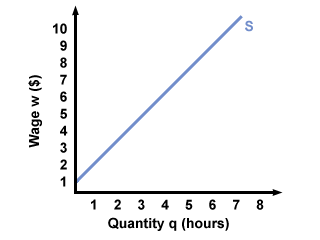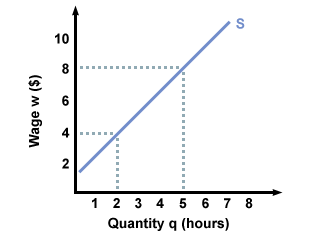Problem :
Tom's supply equation for selling handmade mugs is as follows:
Q = 5 + 1.5P
How many mugs will he sell if the price is $2 a mug? What if the price
is $4 a mug?
Q = [5 + 1.5(2)] = 8 mugs
When the price is $4 a mug, Tom is willing to sell
Q = [5 + 1.5(4)] = 11 mugs
Problem :
Tom's supply equation for his handmade mugs is now:
Q = -5 + 2P
At what price will he no longer be willing to sell mugs?
Q = -5 + 2P
To find the price at which Tom will no longer sell any mugs, we set Q equal to 0 and solve for P. That is:
0 = -5 + 2P
P = 5/2 = $2.50
Tom will not sell any mugs if the price drops to $2.50 a mug.
Problem :
If Jean's supply curve for babysitting looks like this:

Jean's Supply Curve
What is the minimum amount you would have to pay her if you wanted her
to babysit for 2 hours? 5 hours? (Remember that wage is the hourly
rate of pay).
(2 hours) x ($4/hour) = $8
Similarly, to get Jean to work for 5 hours, you have to pay her at least $8 an hour, giving a total pay of
(5 hours) x ($8/hour) = $40

Problem :
Jeff and Luke both sell baseball cards. Jeff's supply function is
Q = 2P
Luke's supply function is
Q = -5 + 3P
If you wanted to buy 50 cards total, how much would you have to offer
per card? At what price will Jeff no longer sell any cards? At what
price will Luke no longer sell any cards?

Now we set Q equal to 50, since we want to buy 50 cards, and we get:
50 = -5 + 5P
Solve for P, and get
P = 55/5 = $11 a card
To find Jeff's no-sell price, we set Q equal to 0 in his supply function and solve for P.
0 = 2P
In this case, we find that Jeff's no-sell price is $0.
We do the same thing for Luke, plugging 0 in for the quantity in his supply equation:
0 = -5 + 3P
P = 5/3 = $1.67 per card
Problem :
Jody owns a used CD store, where she buys and sells used CDs. Which
of the following will cause a movement along her supply curve, and which
will cause a shift in her supply curve?
a) Another CD store opens down the street that also buys used CDs, so
she now has to pay more for the used CDs before she can sell them again.
b) The landlord now includes utilities in her rent payment, so she no
longer has to pay for electricity.
c) There is an Elvis revival, and the market price of used Elvis CDs
goes up.
b) This will cause an outwards shift (a shift away from the y-axis) of Jody's supply curve. Because she no longer has to pay for electricity in her store, Jody's costs are lower, and so she will be willing to sell more CDs at any given price.
c) This causes a movement up the supply curve. Because the market price of used Elvis CDs has gone up, she will be willing to sell more CDs.


 payment page
payment page



